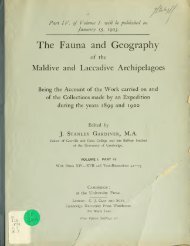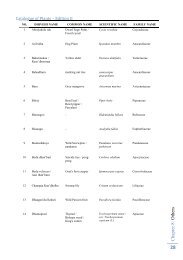Download - WordPress – www.wordpress.com
Download - WordPress – www.wordpress.com
Download - WordPress – www.wordpress.com
Create successful ePaper yourself
Turn your PDF publications into a flip-book with our unique Google optimized e-Paper software.
662 R. C. PUNNETT.apparently devoid both of structure and of nucleus. The origin of these bodies, the " fettartigKiigelchen" of .Spengel and the "eosinophil globules" of Willey, is somewhat obscure. Willeyholds that they are the products of nuclear degeneration ac<strong>com</strong>panied by hypertniphy of thenucleolus. Spengel ('03, p. 306) refuses to believe that they are the out<strong>com</strong>e of degenerativechanges. In the young specimen of Pt. laccadivensis referred to above I have beenable to follow what seems to be the history of these bodies. Certain of the spindle-shapedmesodermal cells be<strong>com</strong>e first oval and then more or less spherical in shape (PI. XL.fig. 38, o b), at the same time increasing slightly in bulk. A few granules make theirappearance in the hitherto clear cytoplasm. A little later these cells appear to collecttogether in clusters of about 6—10 (fig. 38, c), which subsequently fuse together to formgiant cells packed with granules and with the nuclei degenerating (fig. 38, d and e). Laterthe nuclei disappear and the giant cells apply themselves close to the gonad. Where thisoccurs the wall of the gonad seems to break down and by some method which is not clearthe nutriment stored in the giant cells is transferred to the interior of the gonad whereit loses its granular appearance (cf. PI. XL. fig. 37). At later stages small round corpusclesof an eosinophil nature also make their appearance in the mesoderm and subsequently applythemselves to the gonads in a similar manner (PI. XL. fig. 41). The chief interest of theprocess seems to lie in the fact that although the sexual cells themselves are derived fi-omthe ectoderm', it is the mesoderm which provides them with nourishment and which contributesthe yolk to the eggs.The above account is of interest when it is considered with reference to our conceptionof the nature and properties of the coelom. According to present ideas one i>f the chieffunctions of the coelom is to give rise to the generative cells from the epithelium whichlines it. Further it is usually held that the most primitive method of formation of thecoelom is that of archenteric diverticula. In animals like the Enteropneusta, where thismethod of the formation is found, we should naturally look for genital cells arising fromits lining. That this is not so may cause us to regard with some reservation the statementthat the coelom was originally a gonocoel-, and to consider it rather as an organ specialized,among other things, for the reception and maturation of the genital cells.VARIATION IN PTYCHODERA FLAVA.The different varieties of Pt. Jiava are by no means easy to distinguish from one anotherafter preservation. An adequate examination of the characters which are of systematic valueinvolves the preparation of a large number of serial sections. If a trustworthy criterion basedupon external features alone could be found much labour might be spared the Enteropneusticsystematist. The large amount of material collected by Mr Stanley Gardiner has enabledme to attempt this.The characters upon which such a criterion might be based must satisfy two conditions;(1) they must be capable of easy measurement, and (2) they must be independent of the'In this connection it is interesting to notice that so long figs. 88 and 89).ago as 1885 Hubrecht described the ectodermal origin of the - For the most recent general account of the coelom thegonads in the Nemertean Linens gesferensU. He was able reader may be referred to Lankester's Treatise on Zoology,here to distinguish with certainty the primary ectodermal IttOO, Pt. n. chap. ii.connection from the later formed duct (Hubrecht, '8S, PI. v.






